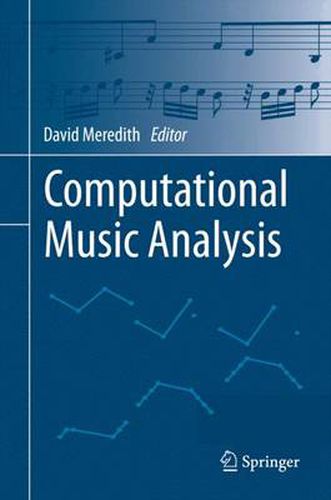Readings Newsletter
Become a Readings Member to make your shopping experience even easier.
Sign in or sign up for free!
You’re not far away from qualifying for FREE standard shipping within Australia
You’ve qualified for FREE standard shipping within Australia
The cart is loading…






This title is printed to order. This book may have been self-published. If so, we cannot guarantee the quality of the content. In the main most books will have gone through the editing process however some may not. We therefore suggest that you be aware of this before ordering this book. If in doubt check either the author or publisher’s details as we are unable to accept any returns unless they are faulty. Please contact us if you have any questions.
This book provides an in-depth introduction and overview of current research in computational music analysis. Its seventeen chapters, written by leading researchers, collectively represent the diversity as well as the technical and philosophical sophistication of the work being done today in this intensely interdisciplinary field. A broad range of approaches are presented, employing techniques originating in disciplines such as linguistics, information theory, information retrieval, pattern recognition, machine learning, topology, algebra and signal processing. Many of the methods described draw on well-established theories in music theory and analysis, such as Forte’s pitch-class set theory, Schenkerian analysis, the methods of semiotic analysis developed by Ruwet and Nattiez, and Lerdahl and Jackendoff’s Generative Theory of Tonal Music.
The book is divided into six parts, covering methodological issues, harmonic and pitch-class set analysis, form and voice-separation, grammars and hierarchical reduction, motivic analysis and pattern discovery and, finally, classification and the discovery of distinctive patterns.
As a detailed and up-to-date picture of current research in computational music analysis, the book provides an invaluable resource for researchers, teachers and students in music theory and analysis, computer science, music information retrieval and related disciplines. It also provides a state-of-the-art reference for practitioners in the music technology industry.
$9.00 standard shipping within Australia
FREE standard shipping within Australia for orders over $100.00
Express & International shipping calculated at checkout
This title is printed to order. This book may have been self-published. If so, we cannot guarantee the quality of the content. In the main most books will have gone through the editing process however some may not. We therefore suggest that you be aware of this before ordering this book. If in doubt check either the author or publisher’s details as we are unable to accept any returns unless they are faulty. Please contact us if you have any questions.
This book provides an in-depth introduction and overview of current research in computational music analysis. Its seventeen chapters, written by leading researchers, collectively represent the diversity as well as the technical and philosophical sophistication of the work being done today in this intensely interdisciplinary field. A broad range of approaches are presented, employing techniques originating in disciplines such as linguistics, information theory, information retrieval, pattern recognition, machine learning, topology, algebra and signal processing. Many of the methods described draw on well-established theories in music theory and analysis, such as Forte’s pitch-class set theory, Schenkerian analysis, the methods of semiotic analysis developed by Ruwet and Nattiez, and Lerdahl and Jackendoff’s Generative Theory of Tonal Music.
The book is divided into six parts, covering methodological issues, harmonic and pitch-class set analysis, form and voice-separation, grammars and hierarchical reduction, motivic analysis and pattern discovery and, finally, classification and the discovery of distinctive patterns.
As a detailed and up-to-date picture of current research in computational music analysis, the book provides an invaluable resource for researchers, teachers and students in music theory and analysis, computer science, music information retrieval and related disciplines. It also provides a state-of-the-art reference for practitioners in the music technology industry.